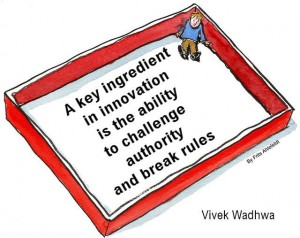Business executives are often told by their managing director to be more innovative, as if the very word will transform their marketing, product development and ultimately create success. It can be hard to act on this when you are not sure what innovation means and what is just old ideas in new packaging.
Innovation is a new idea, or more-effective device or process. Innovation can be viewed as the application of better solutions that meet new requirements, unarticulated needs, or existing market needs. This is accomplished through more-effective products, processes, services, technologies, or business models that are readily available to markets, governments and society. The term “innovation” can be defined as something original and more effective and, as a consequence, new, that “breaks into” the market or society
https://en.wikipedia.org/wiki/Innovation
How can you understand what innovation means if it is new, and you don’t know what it looks like? Original thought is quite tricky at 5 pm on a wet Wednesday when you are firefighting a late delivery, an angry customer or a slump in sales.
 To understand innovation needs a mind shift
To understand innovation needs a mind shift
To understand and create innovation requires a mind shift in your problem solving approach and there are some ways to create this. There is a lovely phrase, “upside-down thinking” which applies when trying to tap into what innovation means. It is best used with another approach, coined by the Tamarack Community – the “Wicked Question” approach.
Wicked questions do not have an obvious answer. They are used to expose the assumptions which shape our actions and choices. They are questions that articulate the embedded and often contradictory assumptions we hold about an issue, context or organization
An example of a wicked question is,
How can we commit ourselves to be accountable for achieving specific measurable results, while at the same time staying open to the possibility that we may be measuring the wrong outcomes?
So, upside down thinking might take that question and say- let’s stop measuring profit and start looking at customer engagement instead. Let us look at variables we have dismissed as unimportant, because we seem to be having no impact on the outcomes we are tracking!
Innovation means asking difficult questions to which, at present, we have no answers. Then, finding the answers through a shift in approach to the problem. Innovation means an avoidance of, “We’ve always done it this way”, because, quite obviously this way isn’t working.
Innovation means risk taking
Most companies are risk averse- but that does not mean risk should be avoided at all costs. Clearly taking a huge risk with product development or marketing strategy is potentially financial disaster which is why pilot innovations are probably the best way to go. Taking a poorly performing product that you are considering ditching and throwing it open to ideas and new approaches is less risky and may well reveal innovative ideas. In this example you could invite anyone in the organisation to contribute ideas as to how to revive a struggling product. Take wellington boots as an example…yes the good old wellie (rain boot, gumboot or billy boot depending on your nationality)
For decades a wellie boot was just black, simple, sturdy, functional and practical. It was very far from a fashion item, although variations such as the green Hunter wellie were developed.
a pair of green Hunters were the weekend uniform of Sloane Rangers,
worn on the moors of Scotland and the damp turf of the Hurlingham club.
http://www.telegraph.co.uk/men/fashion-and-style/11837387/What-your-wellies-say-about-you.html
When Hunter’s went into administration they desperately sought a way to get back into the market and the answer was enlisting the aid of Kate Moss, British fashion icon to wear them and voila…the fashion wellie was born.
In this case innovation means reinventing your market and your design.
Innovation means a fresh perspective
 Looking at a problem from a different angle and using a “what If…” approach where nothing is ruled out can create innovative thinking. The trick here is to resist the urge to say, “No way” or “it will never work”. Everything has to be considered in order to break the constraints that bind a business to a single way of thinking or operating. Great innovative thinkers see the end product/system/business and then figure out how to get there. Staring at the end is a good way to stop linear thinking, especially when the goal seems outrageous. Enlisting others to brainstorm a new approach within a culture that says every idea has merit, also helps with innovative thinking. One thing that is the death to innovative thinking and business practice is bureaucracy as I have previously explained. Innovation means bureaucracy must be knocked on the head!
Looking at a problem from a different angle and using a “what If…” approach where nothing is ruled out can create innovative thinking. The trick here is to resist the urge to say, “No way” or “it will never work”. Everything has to be considered in order to break the constraints that bind a business to a single way of thinking or operating. Great innovative thinkers see the end product/system/business and then figure out how to get there. Staring at the end is a good way to stop linear thinking, especially when the goal seems outrageous. Enlisting others to brainstorm a new approach within a culture that says every idea has merit, also helps with innovative thinking. One thing that is the death to innovative thinking and business practice is bureaucracy as I have previously explained. Innovation means bureaucracy must be knocked on the head!
In my next post I shall look at the idea that being innovative can be a company objective and how to encourage that within business.


